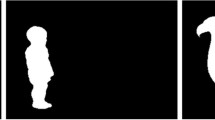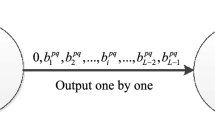Abstract
The fast computation of Zernike moments from normalized geometric moments has been developed in this paper. The computation is multiplication free and only additions are needed to generate Zernike moments. Geometric moments are generated using Hatamian’s filter up to high orders by a very simple and straightforward computation scheme. Other kinds of moments (e.g., Legendre, pseudo Zernike) can be computed using the same algorithm after giving the proper transformations that state their relations to geometric moments. Proper normalizations of geometric moments are necessary so that the method can be used in the efficient computation of Zernike moments. To ensure fair comparisons, recursive algorithms are used to generate Zernike polynomials and other coefficients. The computational complexity model and test programs show that the speed-up factor of the proposed algorithm is superior with respect to other fast and/or direct computations. It perhaps is the first time that Zernike moments can be computed in real time rates, which encourages the use of Zernike moment features in different image retrieval systems that support huge databases such as the XM experimental model stated for the MPEG-7 experimental core. It is concluded that choosing direct computation would be impractical.
Similar content being viewed by others
Explore related subjects
Discover the latest articles, news and stories from top researchers in related subjects.References
Teague M R. Image analysis via the general theory of moments.J. Opt. Soc. Amer., August, 1980, 70(8): 920–930.
Hu M K. Visual pattern recognition by moment invariants.IRE Trans. Information Theory, February, 1962, 8(2): 179–187.
Teh C-H, Chin R T. On image analysis by the method of moments.IEEE Trans. Pattern Analysis Machine Intelligence, July, 1988, 10(4): 496–513.
Hatamian M. A real-time two-dimensional moment generating algorithm and its single chip implementation.IEEE Trans. Acoustics, Speech, and Signal Processing, June, 1986, ASSP-34(3): 533–546.
Al-Rawi M S. High order multi-dimensional moment generating algorithm and the efficient computation of Zernike moments. InICASSP97, Munich, Germany, 1997, 4: 3061–3064.
Li B-C. High order moment computation of gray-level images.IEEE Trans. Image Processing April, 1995, 4(4): 502–505.
Wong W-H, Siu W-C. Improved digital filter structure for the fast moments computation. InIEEE Proceedings Vision, Image and Signal Processing, April, 1999, 146(2): 73–79.
Liu J G, Chan F H Y, Lan F K, Li H F. New approach to fast calculation of moments of 3-D gray level images.Parallel Computing, May, 2000, 26(6): 805–815.
Li B-C, Shen J. Fast computation of moment invariants.Pattern Recognition, 1991, 24(8): 807–813.
Li B-C, Ma S-D. Efficient computation of 3D moments. InProceedings 12th International Conference on Pattern Recognition, Israel, 1994, 1: 22–26.
Bailey R R, Srinath M. Orthogonal moment features for use with parametric and non-parametric classifiers.IEEE Trans. Pattern Analysis and Machine Intelligence April, 1996, 18(4): 389–399.
Belkasim S O, Ahmadi M, Shridhar M. Efficient algorithm for fast computation of Zernike moments. InIEEE 39th Midwest Symposium on Circuits and Systems, Denver, USA, 1996, 3: 1401–1404.
Mukandan R, Ramakrishnan K R. Fast computation of Legendre and Zernike moments.Pattern Recognition, 1995 28(9): 1433–1442.
Kim W-Y, Kim Y-S. A region-based shape descriptor using Zernike moments.Signal Processing: Image Communication, 2000, 16: 95–102.
Jeannin S. MPEG-7 visual part of experimental model version 2.0, ISO/IEC JTC1/SC29/WG11/N2822, Vancouver, July, 1999.
Jeannin S, Bober M. Description of core experiments for MPEG-7 motion/shape. Doc. ISO/IEC JTC1/SC29/ WG11 N2690, 47th MPEG Meeting, Seoul, March, 1999.
Author information
Authors and Affiliations
Corresponding author
Additional information
Supported by the National Natural Science Foundation of China (No.30170274) and the National “863” High-Tech Programme of China (No. 863-306-ZB13-05-6).
Al-Rawi Mohammed was born in 1966, in Iraq, and received his M.S. degree from the College of Sciences, Baghdad University, in 1993. Currently, he is a Ph.D. candidate of the Institute of Image Processing & Pattern Recognition, SJTU. His major research interests are invariant pattern recognition, recognition of color texture, image processing.
YANG Jie was born in 1964, and received his Ph.D. degree from the Department of Computer Science, Hamburg University, Germany. Currently, he is vice director of the Institute of Image Processing & Pattern Recognition, SJTU. He has taken charge of many research projects (e.g. National Natural Science Foundation, National “863” High-Tech, Programme) and published a book in Germany and more than 70 journal papers. His major research interests are object detection and recognition, data fusion and data mining, intelligent systems and applications, medical image processing.
Rights and permissions
About this article
Cite this article
Mohammed, AR., Yang, J. Practical fast computation of Zernike moments. J. Comput. Sci. & Technol. 17, 181–188 (2002). https://doi.org/10.1007/BF02962210
Received:
Revised:
Issue Date:
DOI: https://doi.org/10.1007/BF02962210




